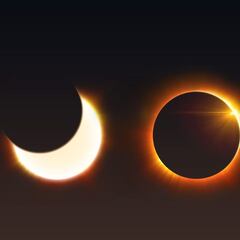What is a total solar eclipse and how often does it occur?
While total solar eclipses happen on a regular basis, for most it’s a once-in-a-generation event since the chance of occurring over the same place is rare.

Monday 8 April, one of the most fascinating astronomical phenomena that exists will take place, a total solar eclipse. Even those who have seen several have difficulty describing the experience in words but magical and awe-inspiring are commonly used adjectives. However, for most it’s a once-in-a-lifetime event that can be scuppered by a cloudy day.
Follow solar eclipse in USA 2024 live online: reactions, best images and latest news.
The total solar eclipse will begin over French Polynesia in the middle of the Pacific. The Moon’s shadow will then speed across the ocean making landfall in Mexico just south of Mazatlan around 11:07 am PT. Subsequently, it will enter the United States through Texas, just north of Eagle Pass, at 12:23 p.m. CT. Its trajectory will mark a direct strip towards the northeast, until it reaches Maine.
Along the way it will enter Canada through southern Ontario and continue through Quebec. Finally passing over New Brunswick, Prince Edward Island, Cape Breton and then out into the open waters of the Atlantic where it will end before reaching Europe.
READ ALSO: All you need to know about the total solar eclipse
What is a total solar eclipse?
A total solar eclipse occurs when the Moon comes between the Earth and the Sun, creating the projection of a shadow on our planet, momentarily plunging part of the day into darkness. The most striking thing about this spectacle is the appearance of the solar corona, the outer atmosphere of the Sun, which becomes visible through a slight glow that surrounds the Moon.
This phenomenon is much awaited by sky watchers, but not everyone will be able to observe it. Only people who are within the narrow band of the lunar umbra shadow will be able to witness the total eclipse. The April 8 event will only be visible in parts of North America.
READ ALSO: Why is the 2024 total solar eclipse better than the one in 2017?
How often does a total solar eclipse occur?
According to NASA calculations, a solar eclipse can occur two to three times per year. However, a total solar eclipse, which is when the Moon completely covers the Sun, usually occurs twice every three years. The agency says that for these to occur in the same place is almost impossible.
Related stories
“On average, about 375 years elapse between the appearance of two total eclipses in the same place. But the interval can sometimes be much longer,” according to NASA.
The next total solar eclipse that will be visible to the world will occur in August 2026. According to Space.com, totality will be visible over the Artic Ocean, Greenland, Iceland, the Atlantic Ocean and Spain. For North America, the next total solar eclipse will take place in March 2033, in Alaska.

Complete your personal details to comment